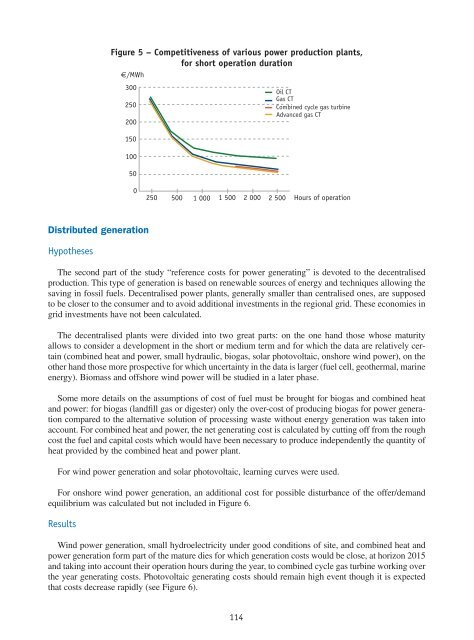Projected Costs of Generating Electricity - OECD Nuclear Energy ...
Projected Costs of Generating Electricity - OECD Nuclear Energy ...
Projected Costs of Generating Electricity - OECD Nuclear Energy ...
You also want an ePaper? Increase the reach of your titles
YUMPU automatically turns print PDFs into web optimized ePapers that Google loves.
Figure 5 – Competitiveness <strong>of</strong> various power production plants,<br />
for short operation duration<br />
€/MWh<br />
300<br />
Oil CT<br />
Gas CT<br />
250<br />
Combined cycle gas turbine<br />
Advanced gas CT<br />
200<br />
150<br />
100<br />
50<br />
0<br />
250 500 1 000 1 500 2 000 2 500 Hours <strong>of</strong> operation<br />
Distributed generation<br />
Hypotheses<br />
The second part <strong>of</strong> the study “reference costs for power generating” is devoted to the decentralised<br />
production. This type <strong>of</strong> generation is based on renewable sources <strong>of</strong> energy and techniques allowing the<br />
saving in fossil fuels. Decentralised power plants, generally smaller than centralised ones, are supposed<br />
to be closer to the consumer and to avoid additional investments in the regional grid. These economies in<br />
grid investments have not been calculated.<br />
The decentralised plants were divided into two great parts: on the one hand those whose maturity<br />
allows to consider a development in the short or medium term and for which the data are relatively certain<br />
(combined heat and power, small hydraulic, biogas, solar photovoltaic, onshore wind power), on the<br />
other hand those more prospective for which uncertainty in the data is larger (fuel cell, geothermal, marine<br />
energy). Biomass and <strong>of</strong>fshore wind power will be studied in a later phase.<br />
Some more details on the assumptions <strong>of</strong> cost <strong>of</strong> fuel must be brought for biogas and combined heat<br />
and power: for biogas (landfill gas or digester) only the over-cost <strong>of</strong> producing biogas for power generation<br />
compared to the alternative solution <strong>of</strong> processing waste without energy generation was taken into<br />
account. For combined heat and power, the net generating cost is calculated by cutting <strong>of</strong>f from the rough<br />
cost the fuel and capital costs which would have been necessary to produce independently the quantity <strong>of</strong><br />
heat provided by the combined heat and power plant.<br />
For wind power generation and solar photovoltaic, learning curves were used.<br />
For onshore wind power generation, an additional cost for possible disturbance <strong>of</strong> the <strong>of</strong>fer/demand<br />
equilibrium was calculated but not included in Figure 6.<br />
Results<br />
Wind power generation, small hydroelectricity under good conditions <strong>of</strong> site, and combined heat and<br />
power generation form part <strong>of</strong> the mature dies for which generation costs would be close, at horizon 2015<br />
and taking into account their operation hours during the year, to combined cycle gas turbine working over<br />
the year generating costs. Photovoltaic generating costs should remain high event though it is expected<br />
that costs decrease rapidly (see Figure 6).<br />
114

















